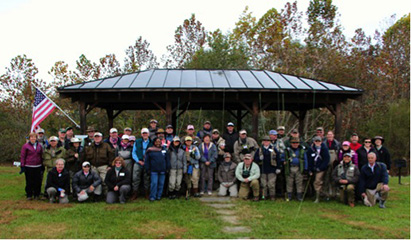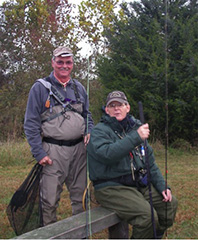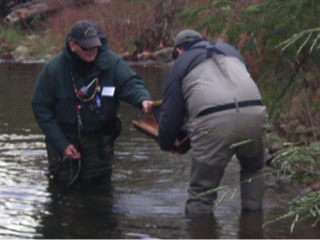


|
The turnout for the Casting For Recovery 2 Fly 4 Hope event held at the Rose River Farm in Syria, VA made it very apparent a great deal of hard work and dedication went into its planning and execution. It also proved the Casting for Recovery program is a great cause and supported by many good and generous people.
Judging from the numbers of smiling faces I saw that day, I would have to declare the event a roaring success. Many thanks go to Kiki Galvin, Mollie Simpkins, Teresa Rodriguez, Pati Nicholson, Carl Smolka, Alan Burrows and so many more good people who donated time, energy and resources to make the day the great event it was. Thanks to you all!
Pam and I arrived at the Rose River Farm at 8:00 AM and registered at the check in desk under the white canvas tent erected to hold the tables later used for the BBQ, the bucket raffles, and the silent auction. The air temperature was 34 degrees.
A few minutes of socializing with old friends, hearing the rules explained to us by Kiki, and getting the crucial information about which beats we had drawn took us to the magic hour of 9:30 AM when the fishing contest officially started. We had until 12:00 PM to catch as many trout as we could, measuring only three fish for the whole day. 2 points were awarded for each trout caught, and the total inches of the three fish chosen to be measured were added to the score as well. In addition, we were each limited to two flies one of which had to display some pink, and if we still had all of our flies at the end of the afternoon session, we would be awarded an additional 10 points. Only rainbow and brown trout were allowed to be measured, giving greater care to quickly releasing the more fragile brook trout. Only barbless hooks or hooks with crimped down barbs were allowed.

|
Victor, our contest monitor, Carl Smolka, and I, dressed like I was going steelhead fishing in Pulaski at the end of November, walked the ten feet or so to our first beat of the day. It was the number 4 beat which was right in front of the tent and gazebo housing the tables used by the officials. Our first view of this pretty stream showed us a riffle, run, riffle, run type structure with shallow glides between deeper runs. The water was really low and gin clear. The bottom was made of softball to cannon ball sized round rocks that were pretty slippery. At the upstream end of our beat there were a couple of huge boulders that sheltered a very deep hole holding some of the biggest fish on the stream. Unfortunately, Carl soon learned that these hogs had a case of lock jaw, and couldn't be enticed to take either of his two flies, a pink honey bug or the cased caddis pupa. He fished the upper section of the 75 yards long beat while I took the lower section. We both attribute the early lock jaw to the cold temperature, however, within the first hour as the air temperature gradually climbed, the activity in the stream improved.
I think Carl may have hooked a great fish but lost it soon after. Both of us landed a couple of very nice brookies, all of which were around 14 to 16 inches and beautifully colored. Before we swapped ends, I also landed and measured what turned out to be a fish that tied for the largest of the day, a rainbow of 17 1/2 inches. Shortly after that it was apparent the fish we had in front of us had seen enough of our flies, so Carl and I swapped positions and tried some more gentle persuasion. The water was so clear, I took off my strike indicator and high stick sight fished my Pink San Juan worm. This method resulted in two heart thumping strikes from 20 inch plus fish but sadly resulted in very quick long distance releases. I have to believe if we had managed to land those three fish, sigh -- oh well, that's why it's called fishing.
By the end of the first session we had a pretty good score, but still had two teams in front of us. At lunch, Carl and I talked just a little about team strategy, and decided we were on the right track by alternating positions to show the fish all of our available flies. We had a most enjoyable lunch then headed for our second beat of the day, # 9. The last beat was much farther downstream and it was another beautiful spot. However, due to the low water, the fish were again concentrated in two spots, leaving most of the water barren. Again Carl and I split up, with him taking the downstream end of the beat and me on the upper end.

|
I had best results with the pink SJ worm, although the Czech caddis nymph produced a couple of fish, too. I worked a shallow run using small strike indicator only about 14 inches from the fly and later just took it off reverting back to the sight fishing high stick method. I pulled a few nice fish from that run and worked it until the fish knew the style hook I was using. Shortly thereafter, Carl and I traded spots. He had hooked and landed a few nice fish, but by now the remaining fish knew his flies by name, too.
Each of us fished hard for the remainder of the time we had, landing two more measurable fish and several fish we did not measure. All in all it was a great day to be on a stream and the company was excellent. I will say the most frustrating part of this contest is the limit of two flies. By the time we quit, I was ready to bribe the monitor into looking the other way so I could break the lock jaw by showing those fish a few more choice flies. All Carl did was laugh.
Much to my surprise, when we reached the scoring gazebo, we learned that we had placed second, and tied for the largest fish. It was a great day, wonderful company, and a very deserving cause. It just doesn't get any better. Thanks go to all who made it happen while my admiration and thoughts go out to those special folks who are fighting the fight.
Jim Greco
P.S. There are a couple of observations I would like to add to Jim's excellent narrative on this event to help those who might follow in our footsteps. The Rose River is not so much a river, but a stream that is, at best, 10-20 yards wide in the two beats we fished. The conditions of the stream bottom allowed us to change position without kicking up much silt so the fish settled down pretty quickly after any of our shuffling or stumbling through the water. My more productive fly in terms of the number of hook ups was the #16 cased caddis nymph fished below a strike indicator but it was also the fly that resulted in the most LDRs. Monday morning quarterback analysis suggests the way I tied this fly resulted in too small of a hook gap. The limit of only using two flies presents the opportunity to get creative: changing the distance between strike indicator and fly, discarding the strike indicator, high sticking, fishing nymphs as wets or streamers. Jim and I also both had a few strikes on our strike indicators. I believe our strategy of using four different flies was a good one -- the only variable is to make sure you pick the right four. I echo Jim's sentiments that it was heartwarming to see the number of people who had volunteered their time and energy to make this a successful fund raising event for breast cancer survivors -- a very worthy cause.
Carl Smolka
I had the opportunity to be a "monitor" for the event and, in fact, monitored the winning team. I thought I would memorialize this so that our competitors next year would be armed with the information.
Kurt Boatman and Ellen Killough had fished the Rose before and were very familiar with the river. Also Kurt (and Ellen?) were the last years winners as well. Kurt know where the fish were likely to be in each of the two beats we fished. The team's flies were 1) pink San Juan Worm 2) Pink Clown fly (egg pattern), 3)pheasant tail nymph and 4)a size 10 Wooly Bugger with a pink bead head. It was clear that these were a team decision and not two separate pairs of flies. Kurt mentioned to me that the egg pattern had "bailed them out" last year.
The team took opposite ends of each beat and covered every part of the water with all three nymphs. Good water as well as marginal water. In fact they ended up measuring a fish that Ellen caught in a section of the beat that neither Kurt nor I would have given a look. If a fisher had to wade into fish to retrieve a fly, they rearranged themselves to continue to cover water in another part of the beat until the fish had recovered in the disturbed area. Toward the end of each session (morning and afternoon) they stripped the wooly bugger through the entire beat with extra casts to known locations.
While they measured 3 good fish (all 16+"), I believe they won because they caught a lot of fish (15). There was no let down or slow down.
Alan Burrows